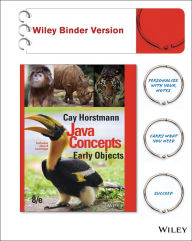
Java Concepts, Binder Ready Version: Early Objects / Edition 8
by Cay S. HorstmannISBN-10: 1119056454
ISBN-13: 9781119056454
Pub. Date: 07/13/2015
Publisher: Wiley
Cay Horstmann's eighth edition of Java Concepts provides an approachable introduction to fundamental programming techniques and design skills, helping readers’ master basic concepts and become competent coders. Updates for the Java 8 software release and additional visual design elements make this student-friendly text even more engaging. The
Overview
Cay Horstmann's eighth edition of Java Concepts provides an approachable introduction to fundamental programming techniques and design skills, helping readers’ master basic concepts and become competent coders. Updates for the Java 8 software release and additional visual design elements make this student-friendly text even more engaging. The text is known for its realistic programming examples, great quantity and variety of homework assignments, and programming exercises that build student problem-solving abilities. The eighth edition now includes problem solving sections, more example code online, and exercise from Science and Business. This text is an unbound, three hole punched version.
Product Details
- ISBN-13:
- 9781119056454
- Publisher:
- Wiley
- Publication date:
- 07/13/2015
- Edition description:
- 8th Edition Binder Ready Version
- Pages:
- 688
- Sales rank:
- 532,786
- Product dimensions:
- 7.90(w) x 9.90(h) x 0.90(d)
Table of Contents
Chapter 1: Introduction
1.1 Computer Programs 2
1.2 The Anatomy of a Computer 3
1.3 The Java Programming Language 6
1.4 Becoming Familiar with Your Programming Environment 7
1.5 Analyzing Your First Program 11
1.6 Errors 14
1.7 Problem Solving: Algorithm Design 15
Chapter 2: Using Objects
2.1 Objects and Classes 32
2.2 Variables 34
2.3 Calling Methods 41
2.4 Constructing Objects 46
2.5 Accessor and Mutator Methods 48
2.6 The API Documentation 50
2.7T Implementing a Test Program 53
2.8 Object References 55
2.9G Graphical Applications 59
2.10G Ellipses, Lines, Text, and Color 64
Chapter 3: Implementing Classes
3.1 Instance Variables and Encapsulation 80
3.2 Specifying the Public Interface of a Class 84
3.3 Providing the Class Implementation 91
3.4T Unit Testing 100
3.5 Problem Solving: Tracing Objects 103
3.6 Local Variables 105
3.7 The this Reference 107
3.8G Shape Classes 110
Chapter 4: Fundamental Data Types
4.1 Numbers 130
4.2 Arithmetic 137
4.3 Input and Output 145
4.4 Problem Solving: First Do It By Hand 152
4.5 Strings 154
Chapter 5: Decisions
5.1 The if Statement 178
5.2 Comparing Values 183
5.3 Multiple Alternatives 193
5.4 Nested Branches 196
5.5 Problem Solving: Flowcharts 203
5.6T Problem Solving: Selecting Test Cases 206
5.7 Boolean Variables and Operators 209
5.8 Application: Input Validation 214
Chapter 6: Loops
6.1 The while Loop 238
6.2 Problem Solving: Hand-Tracing 245
6.3 The for Loop 250
6.4 The do Loop 258
6.5 Application: Processing Sentinel Values 259
6.6 Problem Solving: Storyboards 265
6.7 Common Loop Algorithms 268
6.8 Nested Loops 275
6.9 Application: Random Numbers and Simulations 279
6.10T Using a Debugger 282
Chapter 7: Arrays and Array Lists
7.1 Arrays 308
7.2 The Enhanced for Loop 317
7.3 Common Array Algorithms 318
7.4 Problem Solving: Adapting Algorithms 327
7.5 Problem Solving: Discovering Algorithms by Manipulating Physical Objects 332
7.6 Two-Dimensional Arrays 336
7.7 Array Lists 343
7.8T Regression Testing 352
Chapter 8: Designing Classes
8.1 Discovering Classes 376
8.2 Designing Good Methods 377
8.3 Problem Solving: Patterns for Object Data 386
8.4 Static Variables and Methods 391
8.5 Problem Solving: Solve a Simpler Problem First 395
8.6 Packages 400
8.7T Unit Test Frameworks 405
Chapter 9: Inheritance
9.1 Inheritance Hierarchies 424
9.2 Implementing Subclasses 428
9.3 Overriding Methods 433
9.4 Polymorphism 439
9.5 Object: The Cosmic Superclass 450
Chapter 10: Interfaces
10.1 Using Interfaces for Algorithm Reuse 466
10.2 Working with Interface Types 475
10.3 The Comparable Interface 477
10.4 Using Interfaces for Callbacks 482
10.5 Inner Classes 487
10.6T Mock Objects 489
10.7G Event Handling 490
10.8G Building Applications with Buttons 496
10.9G Processing Timer Events 499
10.10G Mouse Events 502
Chapter 11: Input/Output and Exception Handling
11.1 Reading and Writing Text Files 520
11.2 Text Input and Output 525
11.3 Command-Line Arguments 533
11.4 Exception Handling 540
11.5 Application: Handling Input Errors 549
Chapter 12: Object-Oriented Design (Web Only)
12.1 Classes and Their Responsibilities 566
12.2 Relationships Between Classes 569
12.3 Application: Printing an Invoice 575
Chapter 13: Recursion (Web Only)
13.1 Triangle Numbers 594
13.2 Recursive Helper Methods 602
13.3 The Efficiency of Recursion 604
13.4 Permutations 609
13.5 Mutual Recursion 614
13.6 Backtracking 620
Chapter 14: Sorting and Searching (Web Only)
14.1 Selection Sort 636
14.2 Profiling the Selection Sort Algorithm 639
14.3 Analyzing the Performance of the Selection Sort Algorithm 642
14.4 Merge Sort 647
14.5 Analyzing the Merge Sort Algorithm 650
14.6 Searching 654
14.7 Problem Solving: Estimating the Running Time of an Algorithm 659
14.8 Sorting and Searching in the Java Library 664
Chapter 15: The Java Collections Framework (Web Only)
15.1 An Overview of the Collections Framework 678
15.2 Linked Lists 681
15.3 Sets 687
15.4 Maps 692
15.5 Stacks, Queues, and Priority Queues 698
15.6 Stack and Queue Applications 701
Appendix A THE BASIC LATIN AND LATIN-1 SUBSETS OF UNICODE A-1
Appendix B JAVA OPERATOR SUMMARY A-5
Appendix C JAVA RESERVED WORD SUMMARY A-7
Appendix D THE JAVA LIBRARY A-9
Appendix E JAVA SYNTAX SUMMARY A-53
Appendix F TOOL SUMMARY A-64
Appendix G NUMBER SYSTEMS A-68
Appendix H UML SUMMARY A-76
Appendix I JAVA LANGUAGE CODING GUIDELINES A-79
Appendix J HTML SUMMARY A-86
GLOSSARY
INDEX
CREDITS
Customer Reviews
Average Review: